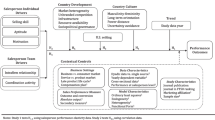Abstract
Sales contests are widely employed to improve short-term sales performance, but knowledge about their effectiveness at the individual salesperson level remains sparse. Proponents argue that contests increase sales by stimulating salespeople, while critics say that contests merely encourage strategic timing of sales efforts. The authors draw on the strategic sales timing literature and goal theory to hypothesize that in a consultative selling scenario, sales will dip below the baseline before the contest but increase above the baseline during and after the contest. They posit that sales district potential and salesperson ability moderate the pre-contest sales dip, contest sales boost, and post-contest sales. Results from a model based on individual-level data on 1180 salespeople in 78 sales districts are largely supportive of the hypotheses. They highlight the need for researchers to integrate the role of strategic timing, salesperson, and sales district characteristics to assess sales contest outcomes. For practitioners, the findings show that in consultative selling situations, contests can generate a net sales increase despite the occurrence of timing games, and the sales gain is higher in districts with lower sales potential and among salespeople with higher sales ability.

Similar content being viewed by others
References
Bandura, A. (1982). Self-efficacy mechanism in human agency. American Psychologist, 37(2), 122–147.
Chen, H., Ham, S. H., & Lim, N. (2011). Designing multiperson tournaments with asymmetric contestants: an experimental study. Management Science, 57(5), 864–883.
Dodge, R. H. (1973). Field sales management: text and cases (pp. 284–289). Dallas: Business Publications, Inc.
Duncan, C. S., Khattak, A. J., & Council, F. M. (2000). Applying the ordered probit model to injury severity in truck-passenger car rear-end collisions (pp. 65–71). Washington DC: Transportation Research Record, Paper No. 98–1237, TRB National Research Council.
Fu, Q., & Jones, E. (2005). How quota setting policy influences salesperson risk behavior and effort level: sandbagging effect. Proceedings of the National Conference in Sales Management.
Garrett, J., & Gopalakrishna, S. (2010). Customer value impact of sales contests. Journal of the Academy of Marketing Science, 38(6), 775–786.
Lim, N., Ahearne, M. J., & Ham, S. H. (2009). Designing sales contests: does prize structure matter? Journal of Marketing Research, 46(3), 356–371.
Marchetti, M. (2004). Why sales contests don’t work. Sales & Marketing Management, 156(1), 19.
Murphy, W. H., & Dacin, P. A. (1998). Sales contests: a research agenda. Journal of Personal Selling & Sales Management, 18(1), 1–16.
Murphy, W. H., & Sohi, R. S. (1995). Salesperson’s perceptions about sales contests: towards a greater understanding. European Journal of Marketing, 29(13), 42–66.
Naik, P. A., Prasad, A., & Sethi, S. P. (2008). Building brand awareness in dynamic oligopoly markets. Management Science, 54(1), 129–138.
Oyer, P. (1998). Fiscal year ends and non-linear incentive contracts: the effect on business seasonality. Quarterly Journal of Economics, 113(1), 149–185.
Ridlon, R., & Shin, J. (2013). Favoring the winner or loser in repeated contests. Marketing Science, 32(5), 768–785.
Singer, J. D., & Willett, J. B. (2003). Applied longitudinal data analysis: modeling change and event occurrence. New York: Oxford University Press.
Sinha, P., & Zoltners, A. A. (2001). Sales-force decision models: insights from 25 years of implementation. Interfaces, 31(3), S8–S44.
Steenburgh, T. (2008). Effort or timing: the effect of lump-sum bonuses. Quantitative Marketing and Economics, 6(3), 235–256.
Tosdal, H. R. (1924). The use of contests among salesmen. Harvard Business Review, 2(4), 480–489.
White, H. (1982). Maximum likelihood estimation of misspecified models. Econometrica, 50(1), 1–25.
Wotruba, T. R., & Schoel, D. J. (1983). Evaluation of salesforce contest performance. Journal of Personal Selling & Sales Management, 3(1), 1–10.
Acknowledgments
The authors wish to thank the insurance company that provided access to several managers permitting extensive discussions and the sharing of proprietary agent-level data. They also thank the Forum for People Performance Management and Measurement at Northwestern University for their support of this research.
Author information
Authors and Affiliations
Corresponding author
Rights and permissions
About this article
Cite this article
Gopalakrishna, S., Garrett, J., Mantrala, M.K. et al. Assessing sales contest effectiveness: the role of salesperson and sales district characteristics. Mark Lett 27, 589–602 (2016). https://doi.org/10.1007/s11002-014-9341-y
Published:
Issue Date:
DOI: https://doi.org/10.1007/s11002-014-9341-y




